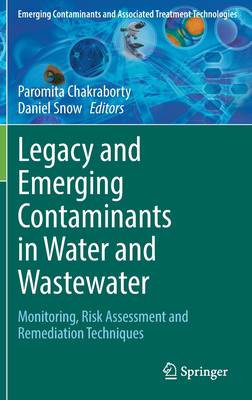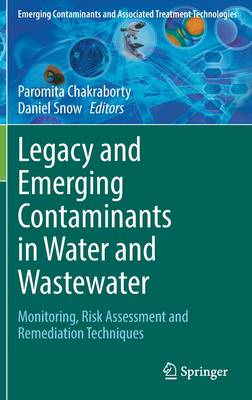
- Afhalen na 1 uur in een winkel met voorraad
- Gratis thuislevering in België vanaf € 30
- Ruim aanbod met 7 miljoen producten
- Afhalen na 1 uur in een winkel met voorraad
- Gratis thuislevering in België vanaf € 30
- Ruim aanbod met 7 miljoen producten
Zoeken
Legacy and Emerging Contaminants in Water and Wastewater
Monitoring, Risk Assessment and Remediation Techniques
€ 137,45
+ 274 punten
Omschrijving
Part 1: State of the science on organic micropollutants in water and wastewater.- Chapter 1-Emerging contaminants in water and wastewater: monitoring, risk assessment and remediation techniques.- Chapter 2-Legacy and emerging contaminants in water: Origin, distribution and implications for human exposure and health.- Chapter 3-Groundwater contamination by persistent organic pollutants in India- A review.- Chapter 4-Fate, Transport and Effects of Pharmaceuticals and Personal Care Products in Urban Environment.- Chapter 5-Phenoxyacid herbicides in water ecosystems- a review on their fate, risk assessment and remediation techniques.- Part 2: Monitoring of organic micropolluntants and their associated risks.- Chapter 6-Water contamination and sources of plasticizers in Asia: a review.- Chapter 7-Antifouling Strategies & Environmental Issues in Industrial Cooling Water Systems in the Marine Environment.- Chapter 8-Measuring emerging contaminants in freshwater systems.- Chapter 9-Optical Techniques in Monitoring of Persistent Organic Pollutants (POPs) in Water and Waste Water.- Part 3: Current approaches for remediation of organic micropollutants.- Chapter 10-Pharmaceuticals in Indian Aquatic Environment: Risk and Implications for Management.- Chapter 11-Suspect and Non-target Screening of Pharmaceuticals in Water and Wastewater Matrices.- Chapter 12-Human exposure and health risks.- Chapter 13-Carbamazepine Residues in Wastewater and River Water: Occurrence, Estimation of Use, and Disposal of this Drug in a Small Community in Western Kentucky, USA.- Chapter 14-Source, Treatment and Management Options of Contaminants of Emerging Concerns (CECs) in Water.- Chapter 15-Emerging Contaminants in Water: Potential Risks and Remedial Techniques.- Chapter 16-Emerging Contaminants Removal from Domestic Wastewater by Advanced Treatment Technologies.- Chapter 17-Treatment Technologies for Emerging Contaminants in Water and Wastewater.- Chapter 18-Novel strategies to treat organic micropollutants.- Chapter 19-Advanced treatment technologies to combat antibiotic resistant bacteria and antibiotic resistance genes from urban wastewater.- Chapter 20-Nanotechnology based treatment strategies for removal of antibiotic and antibiotic byproducts from waste water.- Chapter 21-Levels, sources and removal efficiency of PCDDs/PCDFs and dl-PCBs in water and wastewater in Poland and Europe under the European water directives.
Specificaties
Betrokkenen
- Uitgeverij:
Inhoud
- Aantal bladzijden:
- 415
- Taal:
- Engels
- Reeks:
Eigenschappen
- Productcode (EAN):
- 9783030954420
- Verschijningsdatum:
- 4/06/2022
- Uitvoering:
- Hardcover
- Formaat:
- Genaaid
- Afmetingen:
- 156 mm x 234 mm
- Gewicht:
- 771 g

Alleen bij Standaard Boekhandel
+ 274 punten op je klantenkaart van Standaard Boekhandel
Beoordelingen
We publiceren alleen reviews die voldoen aan de voorwaarden voor reviews. Bekijk onze voorwaarden voor reviews.










